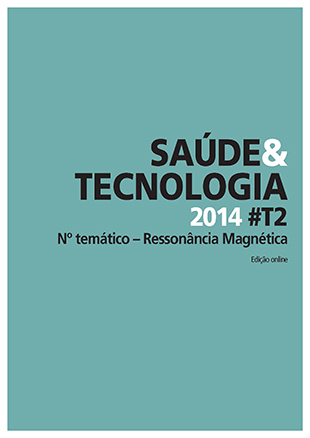Functional MRI imaging in localizing motor paradigm
DOI:
https://doi.org/10.25758/set.1084Keywords:
Functional magnetic resonance imaging, Motor cortex, BOLD signal (blood oxygen-level dependent), Motor paradigmsAbstract
Objectives – Understanding how the brain works were the neuroscience’s goal, since day one. The cerebral analysis developments came along with the widespread of fMRI usage. Following the neuroscience facts, this study aims to identify the cerebral localization of the motor cortex, in a young and healthy population. By allowing a better knowledge of this area, it gives an important contribution to neurology science. Material and methods – fMRIs were performed on 30 healthy subjects, in clinical medical imaging. To achieve this purpose, we employed proper resonance equipment. The motor paradigm used was the fingers’ movement. By the obtained images, the region’s areas were measured. The data were analysed by a statistic program (SPSS version 19). Conclusion – In conclusion, we observed that the area which was more active, when motor paradigms were in execution, relies on the left cerebral hemisphere.
Downloads
References
Khushu S, Kumaran SS, Tripathi RP, Gupta A, Jain PC, Jain V. Functional magnetic resonance imaging of the primary motor cortex in humans: response to increased functional demands. J Biosci. 2001;26(2): 205-15.
Watson C, Kirkcaldie M, Paxinos G. The brain: an introduction to functional neuroanatomy. Academic Press; 2010. ISBN 9780123738899
Carvalho SM. Contribuição da imagem funcional por ressonância magnética para o estudo da reorganização do córtex motor pós-AVCi [Dissertation]. São Paulo: Faculdade de Medicina de Ribeirão Preto; 2006.
Kim PE, Singh M. Functional magnetic resonance imaging for brain mapping in neurosurgery. Neurosurg Focus. 2003;15(1):E1.
Porro CA, Corazza R. Functional magnetic resonance imaging as a tool for investigating human cortical motor function. Arch Ital Biol. 1999;137(2-3):101-14.
Holodny AI, Hou B. Physical principles of BOLD fMRI. In Holodny AI, editor. Functional neuroimaging: a clinical approach (pp. 1-12). New York: CRC Press; 2008. p. 1-12. ISBN 9780849370564
Picard N, Strick PL. Motor areas of the medial wall: a review of their location and functional ativation. Cereb Cortex. 1996;6(3):342-53.
Seeley RR, Stephens TD, Tate P. Anatomia & fisiologia. 8ª ed. Loures: Lusociência; 2013. ISBN 9789728930622
Nunes PR. Ressonância magnética funcional: mapeamento do córtex motor através da técnica BOLD [Dissertation]. Lisboa: Escola Superior de Tecnologia da Saúde de Lisboa/Instituto Politécnico de Lisboa; 2012.
Reis AM, Pereira S, Mascarenhas L, Vaz AR, Pereira JR. Aplicação clínica da RM funcional: avaliação de funções motoras e fluência verbal [Clinical application of functional MRI: motor and verbal fluency tasks evaluation]. Acta Med Port. 2003;16(3):125-30. Portuguese
Bizzi A, Blasi V, Falini A, Ferroli P, Cadioli M, Danesi U, et al. Presurgical functional MR imaging of language and motor functions: validation with intraoperative electrocortical mapping. Radiology. 2008;248(2):579-89.
Huettel SA, Song AW, McCarthy G. Functional magnetic resonance imaging. Sinauer Associates; 2004. ISBN 0878932887
Lucato LT, Amaro Jr E, Leite CC. Neurorradiologia: diagnóstico por imagem das alterações encefálicas. 2ª ed. Rio de Janeiro: Guanabara Koogan; 2008. ISBN 9788527717649
Covolan R, Araújo DB, Santos AC, Cendes F. Ressonância magnética funcional: as funções do cérebro revelados por spins nucleares. Cienc Cult. 2004;56(1):40-2. Portuguese
Silva C. Princípios físicos das imagens de ressonância magnética nuclear. Faro: Universidade do Algarve; 2007 [cited 2013 Apr 9]. Available from: http://w3.ualg.pt/~cmsilva/documentos/RMN_apontamentos.pdf. Portuguese
Carneiro A, Pina S, Moreira B. Arterial spin labeling: experiência inicial, indicações clínicas e dificuldades [Arterial spin labelling: initial experience, clinical impact and difficulties]. Acta Med Port. 2012;25(S1):1-6. Portuguese
Ulmer S, Jansen O. fMRI: basics and clinical applications. Berlin: Springer; 2010. ISBN 9783540681328
Downloads
Published
Issue
Section
License
Copyright (c) 2022 Saúde e Tecnologia

This work is licensed under a Creative Commons Attribution-NonCommercial-NoDerivatives 4.0 International License.
The journal Saúde & Tecnologia offers immediate free access to its content, following the principle that making scientific knowledge available to the public free of charge provides greater worldwide democratization of knowledge.
The journal Saúde & Tecnologia does not charge authors any submission or article processing charges (APC).
All content is licensed under a Creative Commons CC-BY-NC-ND license. Authors have the right to: reproduce their work in physical or digital form for personal, professional, or teaching use, but not for commercial use (including the sale of the right to access the article); deposit on their website, that of their institution or in a repository an exact copy in electronic format of the article published by Saúde & Tecnologia, provided that reference is made to its publication in Saúde & Tecnologia and its content (including symbols identifying the journal) is not altered; publish in a book of which they are authors or editors the total or partial content of the manuscript, provided that reference is made to its publication in Saúde & Tecnologia.







